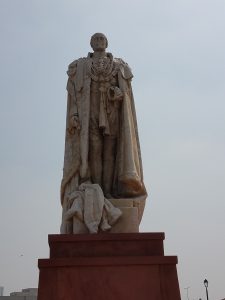Delhi and British Monuments
Bert Dunkerly recently posted about monuments in Eastern Europe. At the end of his post, he stated, I offer these thoughts not necessarily to promote or condone what has been done there, but simply to highlight another perspective. It is a good reminder that issues of monuments, commemoration, and historical memory are worldwide challenges. In that spirit, I wish to offer one more example, this one found on my recent trip to India.
On the north side of Delhi is Coronation Park. The site itself hosted gatherings (durbars) in 1877, 1903, and 1911. In each case, princes and rulers of India came to pay tribute to the new British monarch as each was proclaimed Empress or Emperor of India. Queen Victoria was so crowned in person in 1877, and George V in 1911; the 1903 durbar honored Edward VII (Prince of Wales during the American Civil War) in absentia. The 1911 durbar was also significant as the moment when George V moved India’s capital from Calcutta (modern Kolkata) to Delhi.
After World War I the British government raised a monument to the 1911 durbar in the park, pictured below. It marks the exact site of George V’s throne.
After the British departure from India in 1947, the park fell into disuse. Sometime later, nineteen platforms and an amphitheater were constructed around the durbar monument. Intended to hold various monuments to British figures located around Delhi, only five are occupied. There are no identifiers, but the statues appear to honor various Viceroys of India.
The one exception is George V, relocated in 1968 from a canopy display in central New Delhi by the famous India Gate. It’s base makes it the tallest statue of George V in the world. 
Several statues had their faces vandalized before their relocation. This vandalism appears to be one of the reasons they were moved.
Today, Coronation Park is largely forgotten. (My driver, who had worked in Delhi for 18 years, stated I was the first person he ever encountered who wanted to visit.) There are redevelopment plans by the Delhi Development Corporation to make it a tourist attraction, but progress is slow. Nonetheless, the park is an interesting case study of how India’s capital has treated the monumental legacy of British rule.






No good deed goes unpunished.